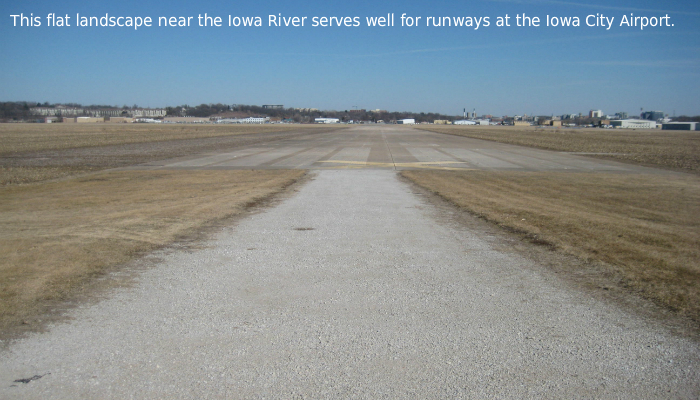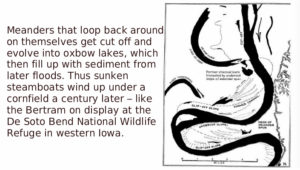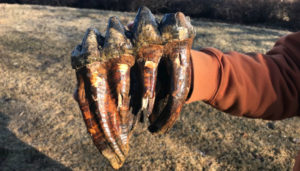Pulling the Plug on Lake Calvin

On the south side of Iowa City there are some very extensive flat lands that run along both sides of the Iowa River and extend southward for several counties. The airport is located on these flats on one side of the river and Hills Bank on the other. More than a century ago, folks also occasionally found ancient teeth and bones weathering out of the river bank and in hand-dug wells on the flats. When brought to the University for identification, faculty like Professor Sam Calvin sometimes identified them as being mammoth, mastodon, camel, and other Ice Age creatures.
The professors also knew that during the Ice Ages a glacial lobe had crept into the southeast corner of Iowa, from Illinois, and this lead to speculation that it had blocked the lower end of the Iowa River, causing it to turn into an enormous temporary lake. The flat lands along the river were therefore perhaps the remnants of the ancient lake bed. In some places, there are multiple terraces, interpreted to represent falling lake levels as the ice dam gradually failed. The bones and teeth were remains of animals that had drowned or washed in during floods.
Professor Calvin’s name came to be associated with this story, and the flat landscape came to be called Lake Calvin. Dr. Sam and others knew that more evidence was needed to prove or disprove this story, but it wasn’t available then. For example, if it were a set of lakebeds, then the elevation of the top terrace should be about the same all the way around the lake. By the early 1970s, the lunar mapping program was underway and there were some portions of the moon with better topographic mapping than was available in Iowa. Finally, in the mid to late 1970s, good maps and elevation control was available here. And when you traced these seemingly flat terraces up the valley and down the valley, they actually had about the same gentle gradient as the modern Iowa River. So they were much more likely to just be river terraces and there was no need for an imagined ice dam or lake.
And so armed with these new base maps, and towing my little drill rig behind his jeep or my carryall, graduate student Steve Esling set out to learn what these terraces actually were. The Iowa Geological Survey followed up with deeper drilling. And it transpires that these are outwash terraces and river terraces built from sands and gravels flooding down the Iowa River from several glaciations, plus interglacial erosion cycles and then blanketed later with finer sediment from lesser floods, plus windblown silts. There is no evidence of a great ice dam or giant lake.


In 1705, an enormous tooth, like the Iowa one I am holding, was found in the Hudson River valley. It wound up in London, and many who saw it supposed that it belonged to some giant carnivore, because of the pointed conical cusps. But Ben Franklin, visiting diplomat, thought it would have been “…useful to grind the small branches of trees.” By 1806, Georges Cuvier had reconstructed the beast from European fossils, had demonstrated that Franklin was correct, and named it the mastodon. And today, they continue to erode out of riverbanks and become rocks in our rivers.
The river in these various cycles created meanders, which evolved into oxbow lakes, and which later filled back up with sediment. So there are patches of lake sediments scattered all up and down the river corridor. But instead of being the product of one large-scale event, they are a collection of little lakes forming since late in the Ice Age, and this is a process still going on today.
But stories have a life of their own, and the Lake Calvin tale is still with us. My copy of today’s Iowa River Water Trail map still repeats the whole imaginary scene, well laced with superlatives – 80 feet deep, 120,000 acres, etc.
So as you paddle your canoe, do watch for ancient teeth and bones eroding out of the banks. And those glacial gravel bars you grind over in shallow riffles are leaking groundwater up into the river. Wiggle your hand down into them on a hot day and feel the cooler water oozing up. There are interesting things to do and see even if there was no enormous lake.
A cheerful thank you to Art Bettis for discussion about Lake Calvin because his involvement is more recent than mine.
Keep watching.
Tags: erosion, fossils, Lake Calvin, Lon Drake, sediments

